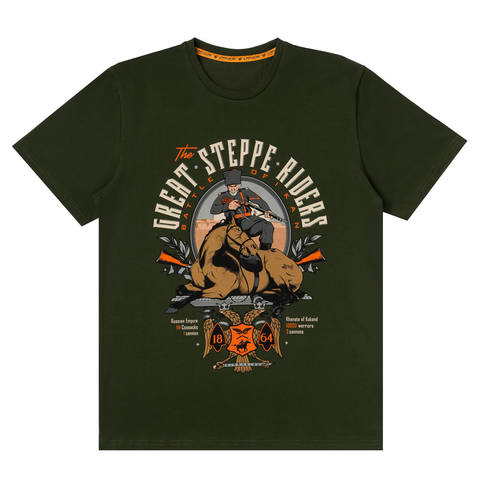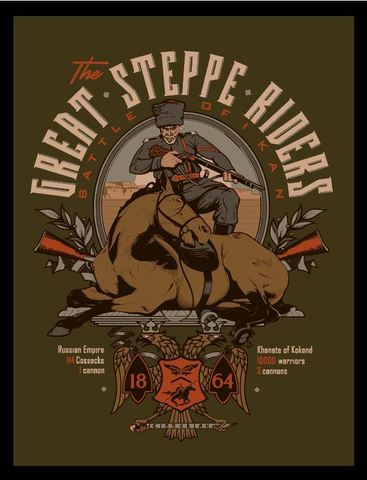Битва под Иканом
Русско-кокандская война началась в 1850 году, успешно развиваясь, привела к заключению с Китаем выгодного Кульджинского торгового соглашения. Была взята, считавшаяся неприступной, крепость Ак-Мечеть на Сырь-Дарье. После некоторого затишья, вызванного Крымской войной, в 1864 был взят Туркестан и Чимкент, где войска тайно проникли в крепость по водопроводу, деморализовав не оказавший сопротивления гарнизон. Дело шло к захвату крупнейшего города Средней Азии — Ташкента.
Регент Коканда мулла Алимкул решил отбить назад крепость Туркестан с еще не восстановленными после перенесенного штурма стенами. 4 декабря его десятитысячное войско при трех пушках достигло селения Икан, находящегося в 20 верстах от города. Подполковник Жежучников, снаряжающий транспорт в Чимкент, получил сообщения от караульного Узурбая о появившихся в окрестностях «ой, таксыр, коп, бек-коп» - «много, очень много» всадниках. Тот час на разведку была выслана сотня есаула Василия Серова в составе: 2 обер-офицеров, 5 урядников (один из них изображен на рисунке), 98 казаков, плюс приданные 4 артиллериста с одной передовой артиллерийской системой того времени – горным единорогом при 42 зарядах, фельдшер, фурштат (обозный) и три киргиза верблюдовожатых. Несмотря на разъезды и предосторожности, к ночи сотня была окружена крупными силами кокандцев, успев лишь занять небольшую канаву, поместить лошадей в центр и забаррикадироваться мешками с провиантом и фуражом. Первая атака кокандцев, возглавляемая бывшим урядником сибирского казачьего войска принявшим мусульманское имя Осман, была остановлена ружейным залпом и картечью с близкого расстояния.

Иллюстрация 1. Знаменитый русский «единорог»
Еще несколько атак были отбиты. В результате коканды расположились лагерем неподалеку. Казаки отправили гонца за подмогой, но как выяснилось позже, он был перехвачен и убит. Ночью казачий бивуак обстреливали из пушек, первая же бомба убила трех лошадей. В последствии почти все животные были перебиты, но пошли на укрепление «бруствера» . На восьмом выстреле у единорога ломалось колесо, но фейерверкер Грехов привязал к нему колеса от зарядных ящиков, ступицы которых хоть были больше по размеру, но позволяли вести огонь, вручную перетаскивая его с места на место, и создавать видимость имеющейся «батареи». Используя преимущество в дальности нарезных ружей против гладкоствольных, казаки убивали кокандских военачальников и подстрелили лошадь даже под самим Алимкулом. На следующий день кокандцы начали строить мантенеты — передвижные щиты из дерева и лозы.
Из Крымской войны, ветераны которой были в составе сотни, были сделаны правильные выводы и в 1856 на вооружение была принята последняя дульнозарядная, но уже нарезная капсульная шестилейная стрелковая винтовка с увеличенной с 300 до 600 метров дальностью прицельного выстрела. Прицел был размечен до 1200 метров, то есть при наличии корректировщика или мощной оптики с грамотным офицером, можно было было вести залповую стрельбу на значительные расстояния. «Казачья» модификация, разработанная мастером Чернолиховым Александром Ефставьевичем была принята на вооружение в 1860 году и имела прицел до 1000 метров, прямую ложу, узкий приклад и "пуговку" вместо спуска по азиатской моде. Критически важным элементом этих винтовок был нарезной ствол малого калибра. Для его производства Тульскому и Ижевскому заводам пришлось обратиться к помощи бельгийских оружейников Фалиса и Трапмана FALISSE&TRAPMANN, Льеж. Они установили 24 нарезательных станка, сверлильные станки, приборы для вырезки оснований прицелов. За изготовление ствола они брали 1 р. 75 коп. (Артиллерийский журнал, 1857, №1, с.62-63) В течение двух с половиной лет они должны были нарезать 100000 стволов.


Иллюстрация 2. Кишлак Икан. Фото из «Туркестанского альбома» (1871—1872)
В русской крепости слышали звуки боя и выслали отряд добровольцев из лучших стрелков на подмогу по главе с поручиком Сукорко. После отправки подкрепления Жемчужников стал опасаться невозможности удержать крепость, располагая оставшимися 300 солдатами и 8 орудиями, поэтому он отправил Сукорко записку со следующим текстом: “Петр Логгинович, ежели вы увидите огромные силы, то, не выручая сотни, вернуться назад, дабы дать средства здешнему гарнизону”. Дойдя до цепи песчаников, из-за которой слышались звуки выстрелов, отряд Сукорко был окружен превосходящими силами. При этом Сыздык-султан, который командовал этим отрядом, направил шесть тысяч воинов в обход Сукорко по направлению к крепости.
Подпоручик Сукорко решил следовать приказу и приказал повернуть назад несмотря на недовольство подчиненных, так как, что и подтвердилось потом, до Серова оставалась всего лишь верста. В последствии это решение вызвало возмущение начальника Ново-Кокандской линии, генерал-майора Черняева, который добился суда для Сукорко за то, “что он из одного постыдного малодушия своевременно не подал помощи уральской сотне есаула Серова, окруженной кокандцами под местечком Иканом, и допустил таковую почти до погибели, ибо если бы Сукорко прошел со своим отрядом еще с версту вперед и поднялся бы на возвышенность, то нет сомнения, что Серов, увидевши прибывшую к нему помощь, сам с сотнею двинулся бы на соединение с ним».
Хотя впоследствии Сукорко и члены его отряда, переведенные из Туркестанского края, были награждены, здесь мы видим столкновение двух разных военных характеров - пылкий, чувствующий, не следующий букве указаний, возможно более «казачий» по духу Черняев и четко исполняющий приказания Сукорко. Сие качество в условиях военного времени часто оказывается более ценным - достаточно вспомнить множество битв проигранных не слушающейся приказов европейской рыцарской кавалерией. Не имея возможности оценить обстановку, находясь под огнем в окружении тысяч басурман, возможно решая судьбу всей крепости с 300 солдатами, которая, приступи Аликул решительно к штурму, была бы в смертельной опасности… Плюс все-таки генерал обладает большей свободой воли и возможностями, чем нижестоящие чины. Я думаю, честь Петра Сукорко чиста. Черняева же было не унять: “Что касается до поручика Сукорко, то не считаю себя в праве держать во вверенных мне войсках, безукоризненно исполняющих свой долг, такого офицера, который бесстрастно оставляет на жертву своих товарищей, имея полную возможность спасти их, — прошу покорнейше о переводе поручика Сукорко из Туркестанской области, которая не существовала бы, если бы все действовали подобно ему” – то есть штурмовали все что можно и нет, как амбициозный генерал.

Иллюстрация 3. Слева казак Андрей Борисов — доброволец, прорвавший в крепость
Тем временем воспрянувшие было духом из-за слышимых из холма выстрелов казаки приняли парламентера с запиской на татарском и печатью муллы Алимкула, которую перевел разведчик Ахмет: «Куда теперь уйдёшь от меня? Отряд, высланный из Азрета, разбит и прогнан назад; из тысячи (!) твоих не останется ни одного, — сдайся и прими нашу веру: никого не обижу!» Посоветовавшись, казаки решили держаться и отправить в крепость вести. На это вызвались казаки Андрей Борисов, Павел Мизинов и Варфоломей Коновалов. Мизинову отказали по здоровью. Двое остальных с киргизом Ахметом, дополнительно вооружившись офицерскими револьверами, двинулись в темноту, но наткнулись на кокандский пикет. Направившись в другую сторону, им удалось пробраться. В 21 час в крепости они встретились с возвратившимся Сукорко, в результате чего было решено послать более сильный отряд.

Иллюстрация 4. Фото киргиза Ахмета - еще одного храброго добровольца.
Начали ладить телеги “приискивать хомут и прочую упряжь на лошадей, фурштатские же батальонные лошади с телегами были отправлены до этого в Джулек за капустой”. Утром есаул решил потянуть время переговорами, просил встречи с Алимкулом. Eму предлагали проехать к нему самому, в случае сдачи обещали сделать военачальником. Увидев, что кокандцы начали катить манетелы, Серов прервал переговоры и вернулся в лагерь. С семи утра сражение вспыхнуло с новой силой, кокандцы приготовили 16 передвижных щитов и валов из хвороста, которые нивелировали преимущество в дальности боя казацких винтовок. Расчет единорога оказался выбит, казак Терентий Толкачев заменил их и метким выстрелом разбил ближайший щит. Атаки следовали одна за одной, к середине дня 37 героев было сражено, почти все оставшиеся были ранены. Не видя подкреплений, отряд решается на отчаянный шаг, заклепав орудие, переломав ненужные ружья, сбросив все лишнее вплоть до верхней одежды, с криком «Ура!» пошли на прорыв. Идя вначале в каре, они сменили строй на три рассеянные шеренги, вокруг свистели пули, кокандские всадники на крупе перевозили стрелков по ходу движения отряда, тяжеловооруженные латники врывались в строй, некоторым удавалось нанести ранения и уйти. Кокандцы набрасывались на упавших и первым делом пытались отрезать голову, чтобы предъявить Аликулу, как трофей. И вот в четыре часа дня, когда начало уже темнеть «вдали сверкнули родные русские штыки» и навстречу им вышел отряд из 204 человек пехоты, 10 казаков при двух орудиях под началом того же подпоручика Сукорко. Комендант Жемчужников отправил его только в час дня(!), до последнего метаясь в сомнениях! То есть спустя 13 часов с момента как гонцы Серова достигли крепости. Может этот офицер на самом деле действовал нерешительно? Последние две версты, завидев храбрецов Серова, солдаты преодолели бегом с криком «Ура!», радость встречи не знала пределов!

Иллюстрация 5. Телеграмма генерал-майора Черняева
В последствии Ташкент со стотысячным населением, 15 тысячами защитников при 63 пушках был взят отрядом Михаила Григорьевича Черняева в две тысячи человек при 12 орудиях. Русские сумели скрытно подобраться к стене ночью через сады, а также имели сторонников за стенами, которые призывали к прекращению сопротивления. Интересно, что военный министр Милютин не давал приказ на взятие Ташкента, изначальным планом компании было выровнять оборонительную линию и остановиться в Чимкенте. Черняев, видя, что кокандцы не чинят решительного сопротивления, желая упредить бухарского эмира и боясь, что собирающийся к нему губернатор «вздумает повести сам войска к Ташкенту, овладеет им, получит графа, а мы, трудящиеся, тут останемся в дураках», проявил инициативу и в результате более чем двухмесячной операции взял город. Как записал в своем дневнике в те дни действительный статский советник Александр Половцев: «Сегодня пришло сообщение, что генерал Черняев взял Ташкент. Никто не знает, почему и зачем. Есть всё-таки что-то эротическое в происходящем на границах нашей империи». За превышение полномочий, из-за недовольства Бухары и сильного международного резонанса особенно со стороны Англии, которая опасалась, что Черняев не остановится и двинет в Индию (салют Павлу I), генерал был снят с должности, но позже вернулся на службу.

В память об Иканском сражении была сложена бывшим командиром этой сотни есаулом А. П. Хорошхиным (убит в деле с кокандцами под Махрамом 22 августа 1875 года) казачья песня «В степи широкой под Иканом» https://www.youtube.com/watch?v=l-V_0xpEIzI
Этот бой часто называют "Русскими Фермопилами", но надо заметить, что фаланга царя Леонида имела врага только с одной стороны и пала, когда персы совершили обходной маневр. Наши же воины, хоть и с современными винтовками, будучи полностью окруженными, прорывались против конницы в рассыпном строю!
Отдельно хочется рассказать про основной промысел уральских казаков или почему в нижней части рисунка на гербе Уральского казачьего войска двуглавом орле красуются два осетра. Яик в Царской России всегда был основным поставщиком икры и красной рыбы. Ниже Уральска на реке был построен учуг — сплошная перегородка реки, которая охранялась вооруженным караулом вплоть до пушек. Право на постройку таких сооружений было одной из старинных казачьих привилегий. Самым известным способом лова было багренье, когда в декабре по пушечному выстрелу казаки выходили на лед, рубили его и баграми тащили рыбу из ям, сразу же продавая излишки на засолку и перепродажу стоящим по берегам купцам.
Существует легенда, что на под осетрами изображен яицкий казак Егор Заморенов по прозвищу "Рыжечка", прославившийся тем, что, будучи в армии Петра Великого, когда государи решили заменить всеобщую битву поединком богатырей, вызвался вступить в единоборство со шведским воином и победил его.


https://obg.kz/delo-pod-ikanom.html
http://www.vostlit.info/Texts/Dokumenty/M.Asien/XIX/1860-1880/Polferov/pozornoe_delo.htm
 En
En Ru
Ru


